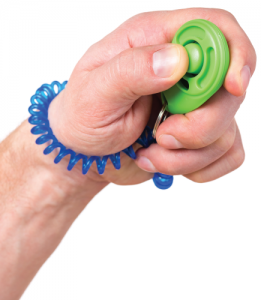
DenisNata / shutterstock.com
You can purchase a dog clicker for about $3 on Amazon.
If you don’t own a dog, this is not a useful piece of information. I don’t own a dog, and the first time I heard the phrase dog clicker, I thought—I think understandably—that it was some sort of remote control.
If you don’t own a dog, but you have seen one of the films in the Jurassic Park reboot, then you have seen a dog clicker in action: It is the device Chris Pratt holds in his hand as he tries to convince his pet dinosaur not to eat him. It is essentially a piece of plastic that makes a clicking sound when a button is depressed.
Its purpose is reinforcement. Everyone knows about using treats to train your dog. But how does the dog learn exactly what action you are rewarding? Is it the sitting, the panting or the soulful look in his eyes?
That’s where the clicker comes in. The dog learns to link the clicking sound to the reward, so he knows exactly what he is doing right and has even more motivation to do it again.
There was no reason for me to know any of this until a trainee—much to his immediate regret—directed me to a story on National Public Radio about the use of a dog clicker in medical education.
Martin Levy is an orthopedic surgeon at Montefiore Medical Center in the Bronx who has started bringing a dog clicker into the operating room. The exact moment the resident does something correctly, they hear a click.1
It’s a really interesting strategy. When I leave a clinic room with a fellow and say, “Good job,” how does the trainee know what I’m complimenting? Was it the nice way she explained how to use the autoinjector? Was it his deft skill with the Finkelstein maneuver? With Dr. Levy’s technique, it would be obvious; they would just hear a click.
As I thought about how to incorporate a dog clicker into my precepting style, I knew how it would end—with my bloodied corpse dumped unceremoniously in some distant corner of the parking lot. The list of suspects would be obvious, and while I would like to think the dog clicker would be found clutched in my hand, you and I both know the autopsy would find the clicker somewhere less comfortable.

